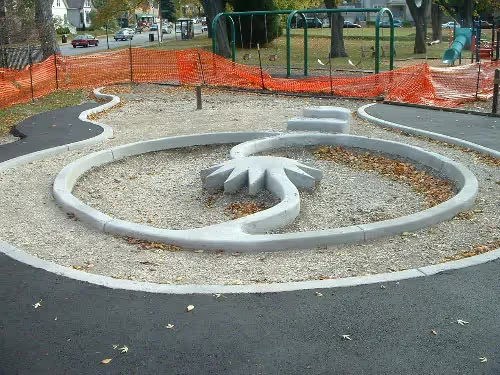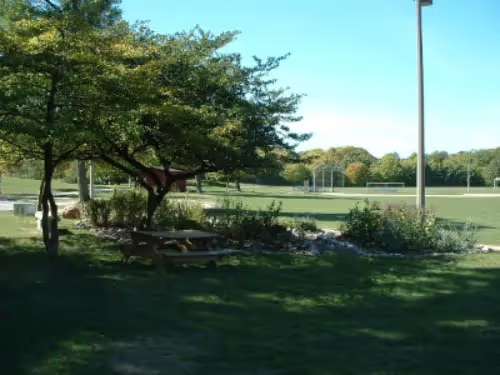A biweekly newsletter with public space news, resources, and opportunities.
A curated dispatch on all things public markets plus the latest announcements from the Market Cities Program.
Please note that these Hall of Shame nominations were written in a moment in time (most over a decade ago) and likely have since changed or even been transformed. If the above entry is now great, or still not so great, go ahead and comment below on how it has evolved or nominate it as a great place.

A neighborhood park with an educational emphasis.

12-acres of open park, wooded land, and riverside habitat. A bike path slices between its two halves where a railroad once existed. The west side of the tracks offers woods and trails down to the river while the east side contains tennis courts, a football field and track, a softball field, and a nature-themed playground. The park also contains the Urban Ecology Center which offers over 40 programs to 12 neighborhood schools. A new center is currently under construction on the south end near the bike path and tennis courts. It is scheduled for completion in the spring of 2004.
Riverside Park fronts one of the east side's busiest streets, Oakland Avenue. The park is located along the 15 bus route that connects with downtown. Street parking is available on both the north and south ends of the park. It is located just south of University Square, which serves the University of Wisconsin-Milwaukee with a variety of food and retail. Very accessible to the high school students as the park is in the backyard of the school. The park itself contains two major paths that allow the high schoolers to go from the school to the bus stop or allow users of University Square to cut through the park to the Riverside neighborhood directly south.
The park makes a good first impression because of the variety of users and options available. Even though it is located on a heavily used street, cars don't make that much of an impact on the quality of the space. Mature trees mixed along with newly planted ones help create many areas of shade. The picnic tables and benches also give a nice aesthetic touch. Another nice feature is the many trash cans around the park. They are not only good for keeping the park clean, but also add to the aesthetic of the park as each can is painted with a mural. There is also a large mural painted on the outside of the bathroom structure located near the playground. The park feels safe to those who use it because of the presence of the Urban Ecology Center, the lights over the paths at night, and a strong visual access to all surrounding sides. The park is never overcrowded and offers both public (open fields) and private areas (tables under groves of small trees) in which to use the park.
This park is used on a regular basis by everyone from kindergartners to the elderly. Activities include reading, sitting, eating, walking, biking, playing, talking, and working. More specifically, tennis, football, baseball, frisbee, and dog walking can all be seen here. The kids seem to enjoy the spider web climbing nets, and will soon enjoy the new woodland dune area, the wetland with otter slides, and the lily pad merry-go-round once construction is complete. 56% of the park users are between the ages of 19-60, 34% re between 7-18, and 10% are between 0-6. One of the parks biggest uses involves the Urban Ecology Center. The neighborhood based non-profit community center and living lab provides programs, promotes environmental awareness, preserves and enhances the natural resources of the park, and protects the Milwaukee River. Over 10,000 students from area schools use the space for outdoor hands-on learning. Some of the topics include river ecology, bird watching, and land restoration.
Riverside Park can be a great place to meet friends because the park caters to all types of users and activities. 65% of users come in groups and 44% of the people interact while using the space. Most of the groups either socialize or eat lunch together. Another portion of the groups are families using the playground or open spaces. Students can enhance friendships here while participating in one of the many programs offered by the Urban Ecology Center.
Riverside Park was created in 1890 as one of three Milwaukee County parks designed by Frederick Law Olmstead. It once sloped into a tree-lined valley; on the northern edge there was a limestone tunnel into the park. There was also a sledding hill, a waterfall, a pavilion and, on the river, skating, swimming, fishing and boating. Topography was flattened in the 1970's for an addition to the adjacent high school. Pollution during this time made the river unfit for swimming, and invasive plants took over as maintenance declined due to budget cuts. In 1991, the Urban Ecology Center was created and began the revitalization process. Environmental Scientist Dr. Else Ankel created the outdoor educational program. Since its conception, crime has vanished and the river has once again become a desirable destination.



*Please note that these Hall of Shame nominations were written in a moment in time (most over a decade ago) and likely have since changed or even been transformed. If the above entry is now great, or still not so great, go ahead and comment below on how it has evolved or nominate it as a great place.